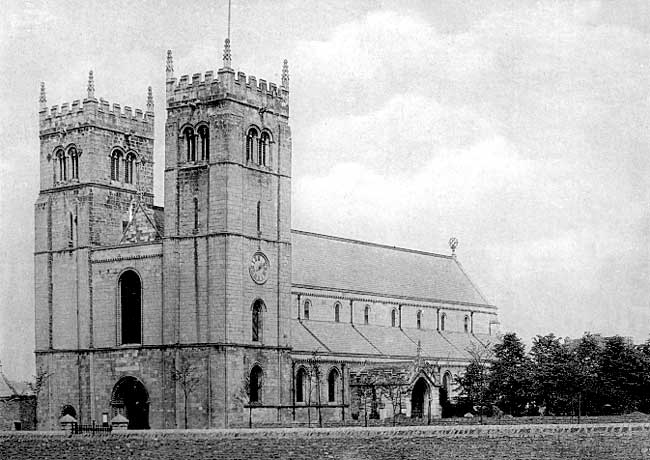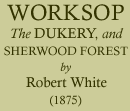< Previous | Contents | Next >
The aisles were originally vaulted, as at present; but the first vaulting appears to have fallen in about the year 1567, from the evidence of the churchwardens’ accounts, and was only restored a few years ago. The easternmost bay of the north aisle was formerly separated from the church by two very thick walls. This formed the canons’ upper entrance to their own church; and a stout oaken door opposite to the external one could be opened for their admission into the presbytery of the parochial church when required. This door was adorned with beautiful ironwork similar to that still remaining on the south door of the church. Latterly, this space was used as the vestry, until another was provided. The two next bays were divided from the parish choir and the remainder of the aisle by screens; an upright of the former still existed against the pillar [g], and the latter was entire, until the late restoration. This space, we believe, formed St. Katherine’s choir, or chantry, thus alluded to in the churchwardens’ accounts, viz.— "Ao Ed. VI. pmo. Itm. payd to Edward Ward for makyng yrons for the glasse wyndow yn Saynte Katheryn’s quere, xiid; for here was the only window of the period thus spoken of, until it was superseded by one of a more appropriate character within the last few years. The small recess (marked i) indicates a locker that belonged to this chapel.
Another doorway originally alone broke the uniformity of this aisle-wall, excepting a sepulchral arch of a date of about 1250, the cloister on its other side preventing the insertion of windows in it; but this wall has now been rebuilt, and is pierced with lights corresponding with those in the south aisle. This last seems to have been treated in the same way as the north aisle, the first bay having apparently been taken off, perhaps to form a sacristy; and the two next were certainly screened-in, so as to form a chapel, probably constituting that of St. Leonard, expressly stated to have been in the parish church, and alluded to previously as the foundation of William Pelliparius. A piscina formerly existed at the point [k]. The south doorway [l], is well proportioned, and contains a door covered with iron scroll-work of a very graceful character. A perpendicular porch now protects this doorway, but evidence is afforded of the existence of an older one by "Torre, 1262;" whence we find John de Gateford desiring in his will, dated 1347, to be buried in the porch of the parish church of Worksop. On the west side of this door was a stoup (marked n) until the time of the late restoration of the fabric. Two other beautiful doorways are in the west end: the one, a very rich one, in the centre of the nave; the other in the northern tower; and there is a newel staircase in the southwestern angle of the southern tower.
Such was the condition of this fine church when the religious storm connected with the Reformation took place. The royal commissioners, George Lawson, Richard Bellasis, William Blithman, and James Rokeby, demanded its surrender, Nov. 15th, 1539, after its dissolution had been ordered by the royal authority. To this the Prior, Thomas Stokkes, and the fifteen canons then resident in it, appear to have made no resistance; and the work of destruction began as soon as they had been expelled from that establishment that was theirs through the grants of a succession of private individuals, and confirmed to their use by several sovereigns of England. Then were all the portable valuables of the church ruthlessly swept away; some destined to reach the treasury of the royal despoiler, but more finding their way into the hands of Jews and brokers. Then perished the storied window-glass, glowing with the hues of rubies and emeralds. Then were broken up the tombs of the ancient lords of Worksop. Then were carried off the very altars that had been so long dedicated to the service of God. Quickly was the lead from the roofs hissing in the melting-pots of the highest bidders for the same; while oaken beams and boards, mingled with rich carved work, were dispersed in a similar manner, for the purpose of being applied to the most ordinary uses, until nothing was left of the Priory church but a mutilated skeleton; and for a time, the parochial church, though spared from the same destruction, appears to have fallen into a state of complete dilapidation, as if in sympathy for its lost twin sister. In 1542, Francis, Earl of Shrewsbury, obtained a grant of the remains of Worksop Priory and its precincts, who would naturally feel well disposed towards the fabric as the representative of its founder; but yet the church appears to have become still more dilapitated subsequent to that date; for in 1567 the vaulting of its aisles had fallen in, and the debris of their roofs was then carried away, the following items from the churchwardens’ books alluding to this :—"Itm. payed to ij men yt watchyd the lead in the church ij nyghts after the falle of the rooffe."—Itm. payed to Medley & other for caryng forthe of stone into the church yard: xlvs. vd."
Probably at this time, when much was apparently done to the church, the triforium arches were converted into windows, and other similar acts of barbarism were committed, although perhaps well intended.
Subsequently the fabric experienced a second period of decadence, lasting until about twenty-five years ago. Such was the condition of the fabric in 1845, when the restoration of its ancient features was commenced, and all that was bad or spurious swept away. Chiefly through the undermining of its foundations by grave and vault makers, its aisle-arcades were found to have declined very considerably from the perpendicular, one of them as much as fifteen inches. These were brought back to their original position very cleverly and successfully by the architect employed, Mr. R. Nicholson, who had to deal with a wall of 117 feet long and 34 feet high, containing 4,000 square feet of material. New bases were also then given to the pillars, and both aisle walls were re-built, in which the old doorways and new windows of an appropriate form were inserted. The triforium arches were then restored, the aisles re-vaulted, and the whole fabric was re-roofed, re-seated, and re-paved. The present pulpit and prayer-desk are of good design, and very beautifully executed; but it is more than questionable whether they have been conceived in a spirit accordant with the character of the church in which they have been placed, or, indeed, with English gothic architecture generally. The last ornament added to the edifice is the beautiful reredos presented to it by his Grace the late Duke of Newcastle, with his usual generosity. This gives great richness to the east end of the church, and, looking from its opposite end, terminates the vista very pleasingly; but when the eye has become accustomed to its varied hues, and can critically trace out all its details, again it becomes a question whether its features accord well with the old fabric it has been placed in; and also whether its really best materials, such as the marble shafts forming a part of the composition, should have been so entirely subdued by the tints emanating simply from the painter’s brush aided by gilding. As a work of art, however, it will command admiration; and the difficulty of treating this end of the church must be borne in mind, consisting, as it does, simply of a veil of masonry, filling up the original central tower-arch. There can indeed be no doubt as to the genius of the designer, Mr. G. G. Scott, nor of the munificence of the noble donor of this reredos.
Externally, dignified simplicity is the characteristic of the remaining portions of Worksop church. Formerly some Decorated windows were inserted in the south aisle, but these have now been replaced by others according with the original design. The west window, between the towers, is of unusually large size, considering its date.
The towers have been capped with angle pinnacles and embattled parapets of the Perpendicular period.

West front of Worksop Priory (c. 1900).
